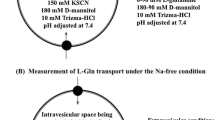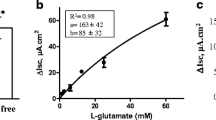Abstract
Plasma glutamate concentrations are constant despite dynamic changes in diets. Most likely, virtually all the dietary glutamate is metabolized in the gut. The present study investigated permeability and metabolism of dietary glutamate in a Caco-2 intestinal epithelial cell layer model by tracing the fate of [U-13C] or [15N]glutamate added to the apical medium. For comparison, several other labelled essential and non-essential amino acids were tested as well. Almost all the labelled glutamate in the apical medium (98% and 96% at 24 h of the culture, respectively) was incorporated in the cell layer, while it barely appeared at the basolateral side, indicating an almost complete utilization of glutamate. Indeed, the 13C was incorporated into alanine, proline, ornithine, and glutamine, and the 15N was incorporated into alanine, glutamine, ornithine, proline, branched chain amino acids and also found as ammonia indicative of oxidation. In contrast, substantial apical-to-basolateral transport of amino acids (8–85% of uptake) other than glutamate and aspartate was evident in studies using amino acid tracers labelled with 13C, 15N or D. These results suggest that the intestinal epithelial cell monolayer utilizes dietary glutamate which adds to maintaining glutamate homeostasis in the body.







Similar content being viewed by others
References
Adibi SA, Mercer DW (1973) Protein digestion in human intestine as reflected in luminal, mucosal, and plasma amino acid concentrations after meals. J Clin Investig 52(7):1586–1594. https://doi.org/10.1172/JCI107335
Artursson P, Karlsson J (1991) Correlation between oral drug absorption in humans and apparent drug permeability coefficients in human intestinal epithelial (Caco-2) cells. Biochem Biophys Res Commun 175(3):880–885. https://doi.org/10.1016/0006-291x(91)91647-u
Blachier F, Boutry C, Bos C, Tome D (2009) Metabolism and functions of L-glutamate in the epithelial cells of the small and large intestines. Am J Clin Nutr 90(3):814S-821S. https://doi.org/10.3945/ajcn.2009.27462S
Broer S, Fairweather SJ (2018) Amino acid transport across the mammalian intestine. Compr Physiol 9(1):343–373. https://doi.org/10.1002/cphy.c170041
Delie F, Rubas W (1997) A human colonic cell line sharing similarities with enterocytes as a model to examine oral absorption: advantages and limitations of the Caco-2 model. Crit Rev Ther Drug Carrier Syst 14(3):221–286
Du J, Li XH, Li YJ (2016) Glutamate in peripheral organs: Biology and pharmacology. Eur J Pharmacol 784:42–48. https://doi.org/10.1016/j.ejphar.2016.05.009
Fleming SE, Fitch MD, DeVries S, Liu ML, Kight C (1991) Nutrient utilization by cells isolated from rat jejunum, cecum and colon. J nutr 121(6):869–878. https://doi.org/10.1093/jn/121.6.869
Food and Nutrition Board IOM, National Academies (2005) Dietary Reference Intakes for Energy, Carbohydrate, Fiber, Fat, Fatty Acids, Cholesterol, Protein, and Amino Acids. The National Academy Press, Washington, D.C.
Hamano Y, Kodama H, Yanagisawa M, Haraguchi Y, Mori M, Yokota S (1988) Immunocytochemical localization of ornithine transcarbamylase in rat intestinal mucosa. Light and electron microscopic study. J Histochem Cytochem 36(1):29–35. https://doi.org/10.1177/36.1.3275711
Hidalgo IJ, Borchardt RT (1990a) Transport of a large neutral amino acid (phenylalanine) in a human intestinal epithelial cell line: Caco-2. Biochem Biophys Acta 1028(1):25–30. https://doi.org/10.1016/0005-2736(90)90261-l
Hidalgo IJ, Borchardt RT (1990b) Transport of bile acids in a human intestinal epithelial cell line, Caco-2. Biochem Biophys Acta 1035(1):97–103. https://doi.org/10.1016/0304-4165(90)90179-z
Hidalgo IJ, Raub TJ, Borchardt RT (1989) Characterization of the human colon carcinoma cell line (Caco-2) as a model system for intestinal epithelial permeability. Gastroenterology 96(3):736–749
Hou Y, He W, Hu S, Wu G (2019) Composition of polyamines and amino acids in plant-source foods for human consumption. Amino Acids 51(8):1153–1165. https://doi.org/10.1007/s00726-019-02751-0
Hou Y, Wu G (2018) L-Glutamate nutrition and metabolism in swine. Amino Acids 50(11):1497–1510. https://doi.org/10.1007/s00726-018-2634-3
Lash LH, Jones DP (1985) Distribution of oxidized and reduced forms of glutathione and cysteine in rat plasma. Arch Biochem Biophys 240(2):583–592. https://doi.org/10.1016/0003-9861(85)90065-7
Li X, Rezaei R, Li P, Wu G (2011) Composition of amino acids in feed ingredients for animal diets. Amino Acids 40(4):1159–1168. https://doi.org/10.1007/s00726-010-0740-y
Mordrelle A, Jullian E, Costa C, Cormet-Boyaka E, Benamouzig R, Tome D, Huneau JF (2000) EAAT1 is involved in transport of L-glutamate during differentiation of the Caco-2 cell line. Am J Physiol Gastrointest Liver Physiol 279(2):G366-373. https://doi.org/10.1152/ajpgi.2000.279.2.G366
Nakamura H, Karakawa S, Watanabe A, Kawamata Y, Kuwahara T, Shimbo K, Sakai R (2015) Measurement of (15)N enrichment of glutamine and urea cycle amino acids derivatized with 6-aminoquinolyl-N-hydroxysuccinimidyl carbamate using liquid chromatography-tandem quadrupole mass spectrometry. Anal Biochem 476:67–77. https://doi.org/10.1016/j.ab.2015.02.002
Nakamura H, Kawamata Y, Kuwahara T, Sakai R (2017) The nitrogen moieties of dietary nonessential amino acids are distinctively metabolized in the gut and distributed to the circulation in rats. J Nutr 147(8):1537–1545. https://doi.org/10.3945/jn.116.241943
Nakamura H, Kawamata Y, Kuwahara T, Torii K, Sakai R (2013) Nitrogen in dietary glutamate is utilized exclusively for the synthesis of amino acids in the rat intestine. Am J Physiol Endocrinol Metab 304(1):E100-108. https://doi.org/10.1152/ajpendo.00331.2012
Nicklin PL, Irwin WJ, Hassan IF, Mackay M, Dixon HB (1995) The transport of acidic amino acids and their analogues across monolayers of human intestinal absorptive (Caco-2) cells in vitro. Biochem Biophys Acta 1269(2):176–186. https://doi.org/10.1016/0167-4889(95)00118-c
Oba M, Baldwin RLt, Bequette BJ (2004) Oxidation of glucose, glutamate, and glutamine by isolated ovine enterocytes in vitro is decreased by the presence of other metabolic fuels. J Anim Sci 82(2):479–486. https://doi.org/10.2527/2004.822479x
Reeds PJ, Burrin DG, Jahoor F, Wykes L, Henry J, Frazer EM (1996) Enteral glutamate is almost completely metabolized in first pass by the gastrointestinal tract of infant pigs. Am J Physiol 270(3 Pt 1):E413-418. https://doi.org/10.1152/ajpendo.1996.270.3.E413
Reeds PJ, Burrin DG, Stoll B, Jahoor F (2000) Intestinal glutamate metabolism. J Nutr 130 (4S Suppl):978S-982S. https://doi.org/10.1093/jn/130.4.978S
Riedijk MA, de Gast-Bakker DA, Wattimena JL, van Goudoever JB (2007) Splanchnic oxidation is the major metabolic fate of dietary glutamate in enterally fed preterm infants. Pediatr Res 62(4):468–473. https://doi.org/10.1203/PDR.0b013e31813cbeba
Sakai R, Cohen DM, Henry JF, Burrin DG, Reeds PJ (2004) Leucine-nitrogen metabolism in the brain of conscious rats: its role as a nitrogen carrier in glutamate synthesis in glial and neuronal metabolic compartments. J Neurochem 88(3):612–622
Satsu H, Hyun JS, Shin HS, Shimizu M (2009) Cycloheximide treatment induces the uptake of neutral and dibasic amino acids via the activation of system b(0,+) in human intestinal Caco-2 cells. J Nutr Sci Vitaminol 55(1):44–51. https://doi.org/10.3177/jnsv.55.44
Steensma A, Noteborn HP, Kuiper HA (2004) Comparison of Caco-2, IEC-18 and HCEC cell lines as a model for intestinal absorption of genistein, daidzein and their glycosides. Environ Toxicol Pharmacol 16(3):131–139. https://doi.org/10.1016/j.etap.2003.11.008
Thwaites DT, Markovich D, Murer H, Simmons NL (1996) Na+-independent lysine transport in human intestinal Caco-2 cells. J Membr Biol 151(3):215–224. https://doi.org/10.1007/s002329900072
Thwaites DT, McEwan GT, Brown CD, Hirst BH, Simmons NL (1994) L-alanine absorption in human intestinal Caco-2 cells driven by the proton electrochemical gradient. J Membr Biol 140(2):143–151. https://doi.org/10.1007/BF00232902
van der Schoor SR, van Goudoever JB, Stoll B, Henry JF, Rosenberger JR, Burrin DG, Reeds PJ (2001) The pattern of intestinal substrate oxidation is altered by protein restriction in pigs. Gastroenterology 121(5):1167–1175. https://doi.org/10.1053/gast.2001.29334
Wu G (1998) Intestinal mucosal amino acid catabolism. J Nutr 128(8):1249–1252. https://doi.org/10.1093/jn/128.8.1249
Wu G, Knabe DA, Yan W, Flynn NE (1995) Glutamine and glucose metabolism in enterocytes of the neonatal pig. Am J Physiol 268(2 Pt 2):R334-342. https://doi.org/10.1152/ajpregu.1995.268.2.R334
Yang RZ, Park S, Reagan WJ, Goldstein R, Zhong S, Lawton M, Rajamohan F, Qian K, Liu L, Gong DW (2009) Alanine aminotransferase isoenzymes: molecular cloning and quantitative analysis of tissue expression in rats and serum elevation in liver toxicity. Hepatology 49(2):598–607. https://doi.org/10.1002/hep.22657
Yasuda MT, Fujita K, Hosoya T, Imai S, Shimoi K (2015) Absorption and metabolism of luteolin and its glycosides from the extract of Chrysanthemum morifolium flowers in rats and Caco-2 cells. J Agric Food Chem 63(35):7693–7699. https://doi.org/10.1021/acs.jafc.5b00232
Acknowledgements
The authors would like to thank Ms. Miyuki Moriyama, Akari Yonaha, Reiko Kawana, and Mayuka Uchida for their research assistance. Work in the authors’ laboratory was funded by Ajinomoto Co., Inc. The author’s responsibilities were as follows: RS, YO, AW, HN, TN: study design; YW, AW, TN, YK, TS: experimentation and sample and data analyses; RS, AT, JBG, TN: manuscript writing. RS takes primary responsibility for the final content. All authors read and approved the manuscript.
Author information
Authors and Affiliations
Corresponding author
Ethics declarations
Conflict of interest
The authors declare that they have no conflicts of interest.
Research involving human participants and/or animals
This article does not contain any studies with human participants performed by any of the authors. This article does not contain any studies with animals performed by any of the authors.
Informed consent
This article does not contain any studies with human participants performed by any of the authors.
Additional information
Handling editor: G. Wu.
Publisher's Note
Springer Nature remains neutral with regard to jurisdictional claims in published maps and institutional affiliations.
Rights and permissions
About this article
Cite this article
Sakai, R., Ooba, Y., Watanabe, A. et al. Glutamate metabolism in a human intestinal epithelial cell layer model. Amino Acids 52, 1505–1519 (2020). https://doi.org/10.1007/s00726-020-02908-2
Received:
Accepted:
Published:
Issue Date:
DOI: https://doi.org/10.1007/s00726-020-02908-2




